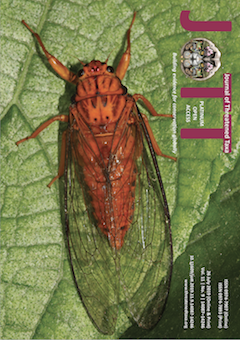Status of water birds in Haripura-Baur Reservoir, western Terai-Arc landscape, Uttarakhand, India
Main Article Content
Abstract
We surveyed water birds in Haripura-Baur Reservoir using total count method between 2013 and 2015. A total of 65 species were recorded representing eight orders and 14 families. Numerically Anatidae was the dominant family followed by Ardeidae and Scolopacidae. Common Coot Fulica atra, Red-crested Pochard Netta rufina, Common Pochard Aythya ferina, Gadwall Anas strepera, and Tufted Pochard Aythya fuligula were dominant species in the reservoir. The Shannon diversity of water birds was more or less consistent over the years and ranged between 2.56 (2013–14) and 2.23 (2015–16). The reservoir supports water birds having declining population trends globally (41% of species), including three Vulnerable (Asian Woollyneck Ciconia episcopus, Lesser Adjutant Leptoptilos javanicus, and Sarus Crane Grus antigone and four Near Threatened species (Oriental Darter Anhinga melanogaster, Painted Stork Mycteria leucocephala, Black-necked Stork Ephippiorhynchus asiaticus, and River Lapwing Vanellus duvaucelii). Bird species belong to four feeding guilds with the domination of the carnivore group. The current information is expected to serve as preliminary database of water birds for further research and monitoring.
Article Details
Authors own the copyright to the articles published in JoTT. This is indicated explicitly in each publication. The authors grant permission to the publisher Wildlife Information Liaison Development (WILD) Society to publish the article in the Journal of Threatened Taxa. The authors recognize WILD as the original publisher, and to sell hard copies of the Journal and article to any buyer. JoTT is registered under the Creative Commons Attribution 4.0 International License (CC BY), which allows authors to retain copyright ownership. Under this license the authors allow anyone to download, cite, use the data, modify, reprint, copy and distribute provided the authors and source of publication are credited through appropriate citations (e.g., Son et al. (2016). Bats (Mammalia: Chiroptera) of the southeastern Truong Son Mountains, Quang Ngai Province, Vietnam. Journal of Threatened Taxa 8(7): 8953–8969. https://doi.org/10.11609/jott.2785.8.7.8953-8969). Users of the data do not require specific permission from the authors or the publisher.
References
Aarif, K.M., A. Nefa, S.B. Muzafar, K.K. Musammilu & P.K. Prasadan (2017). Traditional fishing activities enhance the abundance of selected waterbird species in a wetland in India. Avian Research 8(16): 1–10.
Ali, S. (2002). The Book of Indian Birds. 13th Edition. Oxford University Press, New Delhi, 326pp.
Bhatt, D., V.K. Sethi, S. Santosh, A. Kumar, V. Saini & A. Singh (2014). Water birds of selected wetlands of Uttarakhand, pp140–159. In: Gopi G.V. & S.A. Hussain (eds.). Water Birds of India. ENVIS Bulletin: Wildlife and Protected Areas, Vol. 16, Wildlife Institute of India, Dehradun, 368pp.
Bhattacharjee, A. (2013). First record of Bean Goose Anser fabalis from Uttarakhand, India. Indian Birds 8(2): 46–47.
Bhattacharjee, A. & H.S. Bargali (2013). Diversity and abundance of wetland birds in Tumariya Wetland, Uttarakhand, India and management strategies for their conservation. Indian Forester 139(10): 899–905.
BirdLife International (2016). Species factsheet: Anser fabalis. Downloaded on 25 November 2016. http://www.birdlife.org/
Bolduc, F. & A.D. Afton (2008). Monitoring waterbirds abundance in wetland: the importance of controlling results for variation in water depth. Ecological Modelling 216: 402–408.
Dhakate, P.M., T.A. Patil & R. Bhartari (2008). Wetland birds of Corbett Tiger Reserve Landscape, pp1974–1982. In: Sengupata, M. & R. Dalwani (eds.). Proceeding of Taal 2007: The 12th World Lake Conference, Jaipur, India.
Gopi, G.V., S. Arya & S.A. Hussain (2014). Waterbirds of India: An Introduction, pp10–23. In: Gopi G.V. & S.A. Hussain (eds.). Water Birds of India. ENVIS Bulletin: Wildlife and Protected Areas, Vol. 16, Wildlife Institute of India, Dehradun, 368pp.
Grimmett, R., C. Inskipp & T. Inskipp (1998). Birds of the Indian Subcontinent. Oxford University Press, Delhi, 889pp.
Hammer, O., D.A.T. Harper & P.D. Ryan (2017). PAST< http://folk.uio.no/ohammer/past/>. Accessed on 29 September 2017.
IUCN (2016). The IUCN Red List of Threatened Species.<http://www.iucnredlist.org/> Downloaded on 29 August 2016.
Javed, S., Q. Qureshi & A.R. Rahmani (1999). Conservation status and distribution of swamp francolin in India. Journal of the Bombay Natural History Society 96: 16–23.
Kloskowski, J., M. Nieoczym, M. Polak & P. Pitucha (2010). Habitat selection by breeding waterbirds at ponds with size-structured fish populations. Naturwissenschaften 97(7): 673–682.
Kumar, P. & S.K. Gupta (2009). Diversity and abundance of wetland birds around Kurukshetra, India. Our Nature 7: 212–217.
Naoroji, R. (1999). Status of diurnal raptors of Corbett National Park with notes on their ecology and conservation. Journal of the Bombay Natural History Society 96: 387–398.
Pandey, S., J. Joshua, N.D. Rai, D. Mohan, G.S. Rawat, K. Sankar, M.V. Katti, D.V.S. Khati & A.J.T. Johnsingh (1994). Birds of Rajaji National Park, India. Forktail 10: 105–114.
Rahmani, A.R., G. Narayan, L. Rosalind, R. Sankaran & U. Ganguli (1989). Status of the Bengal Florican (Houbaropsis bengalensis) in India. Journal of the Bombay Natural History Society 88: 349–375.
Rodgers, W.A. & H.S. Panwar (1988). Planning a wildlife protected area network in India. Vol. 1 & II. FAO, Dehradun, 608pp.
Tak, P.C., J.P. Sati & A.N. Rizvi (2010). Status of waterbirds at Hathnikund Barrage wetland, Yamunanagar District, Haryana, India. Journal of Threatened Taxa 2(4): 841–844. https://doi.org/10.11609/JoTT.o2200.841-4

